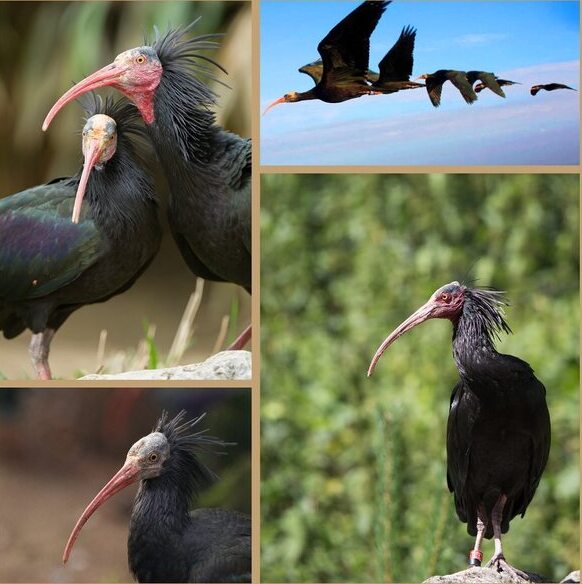The Northern Bald Ibis (Geronticus eremita) is an incredible bird with a rich history, fascinating behavior, and an important ecological role. From its distinct appearance to its struggle for survival, this bird has captivated scientists, conservationists, and even cultural legends. Let’s take a deep dive into the world of the Northern Bald Ibis (Geronticus eremita) and explore what makes it so unique.

The Northern Bald Ibis (Geronticus eremita) is a medium-to-large bird, measuring about 70–80 cm (28–31 inches) in length, with a wingspan of 125–135 cm (49–53 inches). Adults weigh between 1.0–1.3 kg (35–46 ounces). Its striking appearance includes glossy black plumage with a bronze-green and violet sheen, a bald red face, and a long curved red bill. The wispy neck ruff adds to its dramatic look, distinguishing it from other birds.
The diet of the Northern Bald Ibis (Geronticus eremita) is as varied as its habitat. It primarily feeds on small animals, including insects, lizards, and invertebrates. Its long bill helps it forage in rocky terrains, digging into the soil to uncover hidden prey.
This bird is a colonial breeder, preferring cliff ledges for nesting. A female typically lays 2–3 eggs in a nest made of sticks. Both parents share responsibilities, from incubation to feeding chicks. Chicks grow quickly, maturing into fledglings within a few months.
The Northern Bald Ibis (Geronticus eremita) stands out from its relatives in the ibis family for several reasons. Unlike most ibises that thrive in wetlands, this species prefers dry, rocky habitats. Its bald red head is a key feature, contrasting with the feathered heads of other ibises. Its closest relative, the Southern Bald Ibis (Geronticus calvus), shares similar traits but has a whitish face.
In-flight, the Northern Bald Ibis (Geronticus eremita) is often confused with the glossy ibis (Plegadis falcinellus), but its stockier build, shorter neck, and non-protruding legs make it easy to distinguish once you know what to look for.
Historically, the Northern Bald Ibis (Geronticus eremita) roamed across Europe, the Middle East, and North Africa. Today, wild populations are primarily found in Morocco, with smaller reintroduced groups in Turkey, Spain, and Austria.
The Northern Bald Ibis (Geronticus eremita) is migratory. Moroccan populations stay relatively stationary, but reintroduced birds in Europe often migrate seasonally, showcasing remarkable navigational skills.
Unlike other ibises, the Northern Bald Ibis (Geronticus eremita) avoids wetlands. Instead, it thrives in semi-arid grasslands, rocky cliffs, and mountain slopes. Proximity to running water is a bonus but not essential.
The decline of the Northern Bald Ibis (Geronticus eremita) is a cautionary tale of human impact on wildlife. Hunting, habitat loss, and changes in agricultural practices have significantly reduced its numbers. By the 20th century, this bird was nearly extinct in the wild. Conservation efforts, however, are helping to turn the tide.
The Northern Bald Ibis (Geronticus eremita) plays a crucial ecological role as both predator and prey. It controls populations of insects and small reptiles, helping maintain a balanced ecosystem.
This species faces threats from natural predators like eagles and foxes, especially during nesting season. Human interference, however, remains its greatest challenge.
The Northern Bald Ibis (Geronticus eremita) has appeared in historical texts and art for centuries. Ancient Egyptians revered it as a symbol of wisdom and protection.
Today, the Northern Bald Ibis (Geronticus eremita) symbolizes the resilience of nature. Its recovery journey inspires global conservation movements.
Scientific studies have focused on the genetics, behavior, and migration patterns of the Northern Bald Ibis (Geronticus eremita). These studies have informed reintroduction programs and helped refine conservation strategies.
Thanks to international collaboration, wild populations of the Northern Bald Ibis (Geronticus eremita) are slowly increasing. Captive breeding programs have played a significant role in this recovery.
While progress has been made, the Northern Bald Ibis (Geronticus eremita) still faces numerous threats, including habitat degradation and climate change. Continued efforts are crucial to secure its future.
The Northern Bald Ibis (Geronticus eremita) is more than just a bird; it’s a symbol of nature’s resilience and humanity’s capacity for restoration. Through understanding and action, we can ensure that this remarkable species continues to thrive.
This article highlights the Northern Bald Ibis (Geronticus eremita) from every angle, ensuring its significance is well-understood.
animal tags: northern-bald-Ibis
We created this article in conjunction with AI technology, then made sure it was fact-checked and edited by a Animals Top editor.